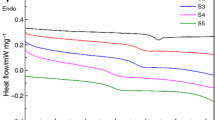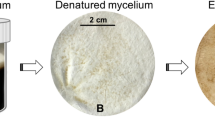Abstract
The current study is directed towards the evaluation of thermal stability and flame retardancy of the epoxy resin hexaglycidyl cyclotriphosphazene (HGCP) cured with 4,4′-methylene dianiline (MDA) and its polymer composite reinforced with bisphenol-A diglycidyl ether (DGEBA) by means of experimental, computational, and statistical approaches. The thermal properties of the polymer materials DGEBA-MDA (M1), HGCP-MDA (M2), and their mixture DGEBA-20%HGCP-MDA (M3) were evaluated using differential scanning calorimetry (DSC) and thermogravimetry–infrared spectroscopy (TG-FTIR) coupled analysis. The morphology was studied by scanning electron microscopy–energy dispersive X-ray analysis (SEM–EDX). The vertical flammability test was done used for the evaluation of the flame retardancy. The temperatures of exothermic peak (To) of the polymer materials M1, M2 and M3 were 95 °C, 77 °C and 93 °C, respectively. The results revealed that the addition of 20% of HGCP enhances the thermal stability compared to DGEBA and provides a DGEBA UL-94 V0 rating. SEM–EDX analysis showed that HGCP promotes the foaming and expansion of the coal as well as improved the gullies on the coal surface. Heteroskedasticity and autocorrelation consistent (HAC) covariance were performed to combine the results of the thermal degradation of the examined epoxy resins as a function of EHOMO and ELUMO, which were obtained from the optimized structure of the epoxy resins using the density functional theory. Consequently, the HAC model was validated by comparing the predicted theoretical results with experimental thermal degradation of the serial of compounds studied.
Graphic abstract












Similar content being viewed by others
References
Dagdag O, Berisha A, Safi Z, Hamed O, Jodeh S, Verma C, Ebenso E, El Harfi A (2020) DGEBA-polyaminoamide as effective anti-corrosive material for 15CDV6 steel in NaCl medium: computational and experimental studies. J Appl Polym Sci 137:48402
Dagdag O, Essamri A, El Gana L, El Bouchti M, Hamed O, Cherkaoui O, Jodeh S, El Harfi A (2019) Synthesis, characterization and rheological properties of epoxy monomers derived from bifunctional aromatic amines. Polym Bull 76:4399–4413
Dagdag O, El Gana L, Hamed O, Jodeh S, El Harfi A (2019) Anticorrosive formulation based of the epoxy resin-polyaminoamide containing zinc phosphate inhibitive pigment applied on sulfo-tartaric anodized AA 7075–T6 in NaCl medium. J Bio- Tribo-Corros 5:25
Bekhta A, Elharfi A (2016) Comparative study of the rheological and thermal properties of the formol phenol novolac epoxy and those of the model resin diglycidylether of bisphenol A (DGEBA). Moroccan J Chem 4:61–67
Jalila EA, El- Aouni N, El-Harfi A (2016) Synthesis, structural characterization by NMR and IR and rheological study of epoxy resin octafunctional. Moroc J Chem 4:2014–2023
Li L, Cai Z (2020) Flame-retardant performance of transparent and tensile-strength-enhanced epoxy resins. Polymers 12:317
Song K, Wang Y, Ruan F, Liu J, Li N, Li X (2020) Effects of a macromolecule spirocyclic inflatable flame retardant on the thermal and flame retardant properties of epoxy resin. Polymers 12:132
Rane AV, Abitha V, Jadhava S (2020) Non-isocyanate polyurethane systems: a review. Moroc J Chem 8:8–4
Huang R, Guo X, Ma S, Xie J, Xu J, Ma J (2020) Novel phosphorus-nitrogen-containing ionic liquid modified metal-organic framework as an effective flame retardant for epoxy resin. Polymers 12(1):108
Jadhav SA, Rane A, Abitha V, Suchithra P, Patil SS, Narute ST (2015) Polymeric particle board: a sustainable substitute to wooden boards. Moroc J Chem 3:2723–2729
Lejeune N, Dez I, Jaffrès PA, Lohier JF, Madec PJ, de Oliveira S, Santos J (2008) Synthesis, crystal structure and thermal properties of phosphorylated cyclotriphosphazenes. Eur J Inorg Chem 2008:138–143
Krishnamurthy S, Sau A, Woods M (1978) Cyclophosphazenes. Adv Inorg Chem Radiochem 21:41–112
Allen CW (1991) Regio-and stereo-chemical control in substitution reactions of cyclophosphazenes. Chem Rev 91:119–135
Dagdag O, El Bachiri A, Hamed O, Haldhar R, Verma C, Ebenso E, El Gouri M (2021) Dendrimeric epoxy resins based on hexachlorocyclotriphosphazene as a reactive flame retardantpolymeric materials: a review. J Inorg Organomet Polym Mater 3:1–22
Chang JY, Rhee SB, Cheong S, Yoon M (1992) Synthesis and thermal reaction of acetylenic group substituted poly (organophosphazenes) and cyclotriphosphazene. Macromolecules 25:2666–2670
Heyde M, Moens M, Van Vaeck L, Shakesheff KM, Davies MC, Schacht EH (2007) Synthesis and characterization of novel poly [(organo) phosphazenes] with cell-adhesive side groups. Biomacromol 8:1436–1445
Allcock HR, Austin PE (1981) Schiff base coupling of cyclic and high-polymeric phosphazenes to aldehydes and amines: chemotherapeutic models. Macromolecules 14:1616–1622
Levchik GF, Grigoriev YV, Balabanovich AI, Levchik SV, Klatt M (2000) Phosphorus-nitrogen containing fire retardants for poly (butylene terephthalate). Polym Int 49:1095–1100
Allen CW (1993) The use of phosphazenes as fire resistant materials. J Fire Sci 11:320–328
Gu JW, Zhang GC, Dong SL, Zhang QY, Kong J (2007) Study on preparation and fire-retardant mechanism analysis of intumescent flame-retardant coatings. Surf Coat Tech 201:7835–7841
Dagdag O, Hsissou R, Berisha A, Erramli H, Hamed O, Jodeh S, El Harfi A (2019) Polymeric-based epoxy cured with a polyaminoamide as an anticorrosive coating for aluminum 2024–T3 surface: experimental studies supported by computational modeling. J Bio- Tribo-Corros 5:58
Dagdag O, Hamed O, Erramli H, El Harfi A (2018) Anticorrosive performance approach combining an epoxy polyaminoamide-zinc phosphate coatings applied on sulfo-tartaric anodized aluminum alloy 5086. J Bio- Tribo- Corros 4:52
Dagdag O, Safi Z, Hamed O, Jodeh S, Wazzan N, Haldhar R, Safi SK, Berisha A, El Gouri M (2021) Comparative study of some epoxy polymers based on bisphenolic and aromatic diamines: synthesis, viscosity, thermal properties computational and statistical approaches. J Polym Res 28:1–16
Frisch MJ, Trucks GW, Schlegel HB, Scuseria GE, Robb MA, Cheeseman JR, Scalmani G, Barone V, Mennucci B, Petersson GA et al (2009) Gaussian 09 RA (2009), vol 121. Gaussian Inc, Wallingford, pp 150–166
Cossi M, Barone V (1998) Analytical second derivatives of the free energy in solution by polarizable continuum models. J Chem Phys 109:6246–6254
Cammi R, Tomasi J (1995) Remarks on the use of the apparent surface charges (ASC) methods in solvation problems: iterative versus matrix-inversion procedures and the renormalization of the apparent charges. J Comput Chem 16:1449–1458
Cances E, Mennucci B, Tomasi J (1997) A new integral equation formalism for the polarizable continuum model: theoretical background and applications to isotropic and anisotropic dielectrics. J Chem Phys 107:3032–3041
Sastri V, Perumareddi J (1997) Molecular orbital theoretical studies of some organic corrosion inhibitors. Corrosion 53:617–622
Erdoğan Ş, Safi ZS, Kaya S, Işın DÖ, Guo L, Kaya C (2017) A computational study on corrosion inhibition performances of novel quinoline derivatives against the corrosion of iron. J Mol Struct 1134:751–761
Guo L, Safi ZS, Kaya S, Shi W, Tüzün B, Altunay N, Kaya C (2018) Anticorrosive effects of some thiophene derivatives against the corrosion of iron: a computational study. Front Chem 6:155
Parr RG, Donnelly RA, Levy M, Palke WE (1978) Electronegativity: the density functional viewpoint. J Chem Phys 68:3801–3807
Froimowit M (1993) HyperChem: a software package for computational chemistry and molecular modeling. Biotechniques 14:1010–1013
Acknowledgements
NuhaWazzan and Zaki Safi gratefully acknowledge King Abdulaziz University’s High-Performance Computing Centre (Aziz Supercomputer) (http://hpc.kau.edu.sa) for assisting with the calculations for this study.
Author information
Authors and Affiliations
Corresponding authors
Ethics declarations
Conflict of interest
There are no conflicts to declare.
Supplementary Information
Below is the link to the electronic supplementary material.
Rights and permissions
About this article
Cite this article
Dagdag, O., El Gouri, M., Safi, Z.S. et al. Flame retardancy of an intumescent epoxy resin containing cyclotriphosphazene: experimental, computational and statistical studies. Iran Polym J 30, 1169–1179 (2021). https://doi.org/10.1007/s13726-021-00967-0
Received:
Accepted:
Published:
Issue Date:
DOI: https://doi.org/10.1007/s13726-021-00967-0




